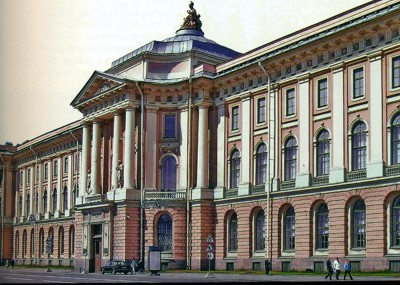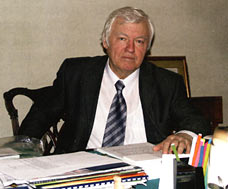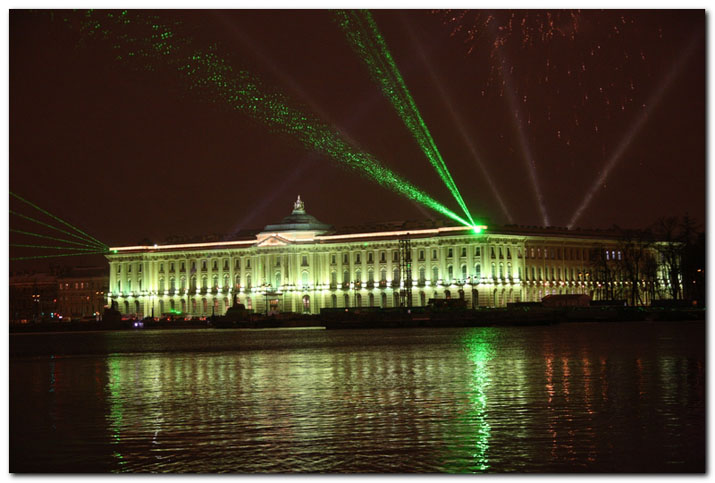I.E. Repin State Academic Institute for Painting, Sculpture and Architecture

I.E. Repin St.-Petersburg State Academic Institute for Painting, Sculpture and Architecture together with V.I. Surikov Moscow State Academic Art Institute comprises the structure of Russian Academy of Arts. The main goal is educational training for students in keeping with the best traditions of Russian art school. The leading and largest faculties are the faculties of painting where after finishing second year students get an opportunity of working in personal studios.

The Head of the I.E. Repin St.-Petersburg State Academic Institute for Painting, Sculpture and Architecture is Albert S. Charkin, a full member of Russian Academy of Arts, an honored artist of Russia.
Albert Charkin about the Institute:
"The Institute occupies all the floors of the Russian Academy of Arts including the attics. Here at the very top of the building in the XIXth century large studios for artists were located. For a long-term existence of the Institute the purpose of its rooms had been changed several times. But there are still such “zones” which functions did not change with the course of time. For example, in XVIIIth century in the North Eastern part of the building, on the first floor there had homed a dining room (with the kitchen and storage rooms) for students. The former life drawing classroom has practically the same function. Now it is an anatomy room located on the second floor in the north western projection. It is still has the seats with fold-out easels for students disposed in the form of amphitheater, and an original “stage” – podium for models.
Near this room, in place of colour grinding room, there is a laboratory for monumental painting. In the same west block there is one more very important for the University laboratory – here students study technique and technologies of painting. Specialists of the laboratory guide in students’ studies during the practice period when they penetrate into the secrets of old masters, copy their works kept in museums of the world. Some of the studying rooms are adapted for slide lectures: here the faculty of theory and history of arts works. Dean’s Office for this faculty neighbours on the Dean’s Office for the faculty of painting.
Painting studios are traditionally situated on the second floor, but in the north block. On the first floor there are rooms of the faculty of graphics. Here students learn different techniques – wood and steel engraving, lithography, etching, linocut. In one of the studios there are made with a special print impressions – reproductions from originals chosen by the students.
On the third floor, also according to the traditions of many years, they give classes for students of the faculty of architecture. The faculty occupies a half of a so-called circle (another half is given over to the museum exposition). Here is located the largest study room where juniors under the guidance of their teachers perform tasks in architectural graphics and design.
In the middle of the west block on the third floor there is a room of architecture with depository for faculty guidance materials funds. It is some kind of a museum where the best study and graduate works of students are kept. Some of them are shown here in the room. From time to time this exposition is renewed what allows new generations of students to find out more about the works of their foregoers. Large albums with photocopies of the students’ works have the same function. Great number of photos with images of architectural masterpieces is used as manuals while studying history of architecture.
One more study cabinet - cabinet for history of arts – is situated on the first floor in the south west part of the building. It serves as a storage space for a large collection of photographic negatives and photos presenting very different periods of domestic and foreign history of arts. One can always get a lot of information about the teaching programmes of every discipline, learning materials and collections of works on different issues of theory, history, and practice of arts. On the first floor of the building just in front of the Rector’s Office there is one more department playing an important role in life of the Institute. This is a Salon – rather large room which is sometime used as an exhibition area. Here students and teachers’ works of different kinds and genres of arts are shown. Every spring Salon changes its function. It is placed at disposal of the Admission Committee of the Institute. Right here the long way into the great art for a large number of students begins.
Admission examinations take place in July. Usually 5 – 6 applicants, got admission to exams, claim for one place at the Institute. In order to make sure that the artistic background level of potential students is high enough for entering the University Members of Admission Committee examine their works – drawings, sketches from nature, compositions. As a rule students are the former pupils of secondary schools of art. Before entering the University many of them attend preliminary courses held by artists who know about all the requirements specified in the Institute.
The next step for the University entrants is a test in art – drawing, painting and composition. Yong people are given two tasks on each of these disciplines; they are to write an essay and pass an oral examination in history of arts. They have several days to cope with it.
In departments preparing artists there are personal studios headed by the most experienced and respected teachers. Students enter these studios only after the second years of their studies.
Our teachers use all the achievements of classical pedagogy. From the very first day a future artist makes dozens of tasks in drawing, panting, sculpture, architectural graphics, etc. under the guidance of their tutors. In course of time these tasks become more and more complicated. Students have classes in surface anatomy, world’s history, literature, history of arts, philosophy, aesthetics, history of religions, and foreign languages. They study qualities of materials which they use in their works, learn the techniques of different arts. Students of Architectural Departments besides the artistic disciplines are to study numerous engineering and technical subjects: from mathematics and descriptive geometry to acoustical and sanitary engineering. Studying of laws of composition plays one of the leading roles in the educational process. The Institute gives a wonderful opportunity for its students to work under the guidance of the experienced masters in their own studios.
Exhibitions of graduation works are held in the staterooms of the Academy every summer. Then the best works go to the National Research Museum. Every autumn there are held exhibitions of students’ works.
The teaching staff of the Institute consists of honorary pedagogues possessing different degrees and awarded the numerous prizes. They are all members and corresponding members of Academy of Arts and Industrial Academies, authors of books, textbooks, and manuals.

Our Institute enjoys the world-wide authority, maintains close contacts with the similar State Institutions located in Europe, the USA, China. We regularly exchange students and teachers, organize joint exhibitions and seminars; publish catalogues and other printed works. Students from foreign countries have a great opportunity to be educated here. Nowadays over 80 foreign students came to St.-Petersburg to study in our Institute.
In the end of study all students are to write a graduation work – where young artists or art historians demonstrate the acquired knowledge. As a rule defence ceremonies take place in the staterooms of Academy of Arts as well as in conference rooms. All works are estimated by the state professional licensing board. If a work meets all the requirements we congratulate its author and wish him/her success in the future."
Our address:
199034 St.-Petersburg, Universitetskaya Naberezhnaya, 17
Tel.: +7 812 323 21 11



